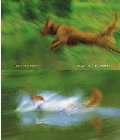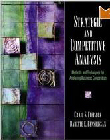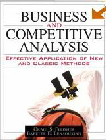BOOKS
DOI:
https://doi.org/10.24883/IberoamericanIC.v3i1.50Palavras-chave:
AnalysisResumo
The Institute for Competitive Intelligence fez uma lista de livros para aqueles que querem se desenvolver com mais profundidade em “Análise” na área de Inteligência Competitiva.

Structured Analysis of Competing Hypotheses
Diane E. Chido
Richard M. Seward Junior
Katrina M. Altman
James J. Kelly
Kristan J. Wheaton
MCIIS has a research and production arm, the Center for Information Research and Analysis Training (CIRAT), through which qualified students deliver industry-standard open-source research products for a growing number of government and private agencies devoted to intelligence analysis. The Analytic Methodologies Project (AMP) is one CIRAT initiative promoting the discipline of intelligence analysis education throughout the US intelligence community. This Manual is one of a series of training packages CIRAT is producing to teach analysts the most effective methods for performing analysis.

A Manager's Guide to Technology Forecasting and Strategy Analysis Methods
Stephen M. Millett
Edward J. Honton
Technology forecasting is one of the most formidable challenges facing many organizations. In A Manager's Guide. Stephen Millett and Edward Honton provide a guide for corporate and technology managers, planners, and analysts looking for a foundation on which to base technological forecasts and decision making. The authors assess 20 forecasting methods, evaluate their advantages and disadvantages, and suggest applications and uses. This book provides a profile of the technology forecasting and strategy analysis methods available today to guide input to the corporate decision making process.

Financial Accounting: Introduction to Concepts, Methods and Uses
Clyde P. Stickney
Roman L. Weil
This widely respected financial accounting text captures the predominant market share among graduate, MBA, and higher-level undergraduate programs.With great clarity, it presents both the basic concepts underlying financial statements and the terminology and methods that allow students to interpret, analyze, and evaluate actual corporate financial statements.

Military Intelligence Blunders
John Hughes-Wilson
Colonel John Hughes-Wilson
In this controFrom the Back Cover:versial book, a long-serving professional military intelligence officer gives an insider’s view of some of the great intelligence blunders of recent history.Colonel John Hughes-Wilson analyses not just the events that conspire to cause disaster, but why crucial intelligence is so often ignored, misunderstood or undervalued by politicians and seasoned generals alike. From Stalin’s Operation Barbarossa to the Gulf War 1991, the many examples here include:
- How Hitler’s own intelligence staff deliberately misled him in a bid to outfox their Nazi Party rivals.
- The bureaucratic bungling and inter-service rivalries that enabled the devastating attack on Pearl Harbor, even though the US was reading Japan’s most secret radio traffic.
- The Viet Cong’s Tet Offensive of 1968, which took the world’s most technologically advanced army completely by surprise.
- The over-confidence, political interference and clever Arab deception that nearly inflicted a crushing defeat on Israel in 1973.
- Why a handful of marines and a London taxicab were all Britain had to -
The dramatically mistaken intelligence which left Saddam Hussein in power nearly a decade after the Gulf War of 1991.

The Thinker's Toolkit: 14 Powerful Techniques for Problem Solving
Morgan D. Jones
An invaluable resource for any manager or professional, this book offers a collection of proven, practical methods for simplifying any problem and making faster, better decisions every time.

Accounting for Growth: Stripping the Camouflage from Company Accounts
Terry Smith
Accounting for Growth is a deliberate play on words: Was most of the growth seen in company profits during the 1980s due to the improved efficiency of British industry or was it generated from the manipulation of profits by creative accounting? Terry Smith strips away the camouflage of creative accounting to allow readers to examine company accounts afresh and decide whether profits are genuine and how strong a company’s finances really are. Each of the creative accounting techniques examined is accompanied by examples from actual public company reports and accounts to enable readers to follow the techniques used and to perform their own analysis.

Systems Thinking: Managing Chaos and Complexity: A Platform for Designing Business Architecture
Jamshid Gharajedaghi
In a nutshell, this book is about systems. This book is written for those thinkers and practitioners who have come to realize that while the whole is becoming more and more interdependent parts display choice and behave independently, and that paradoxes are the most potent challenge of emergent realities.With a practical orientation and yet a profound theoretical depth, the book offers an operational handle on the whole by introducing an elaborate scheme called iterative design. The iterative design explicitly recognizes that choice is at the heart of human development. Development is the capacity to choose; design is a vehicle for enhancement of choice and holistic thinking. 'Designers', in this book, seek to choose rather than predict the future. They try to understand rational, emotional, and cultural dimensions of choice and to produce a design that satisfies a multitude of functions. They learn how to use what they already know and also about how to learn what they need to know. The imperative of interdependency, the necessity of reducing endless complexities, and the need to produce manageable simplicities require a different mode of thinking, a holistic frame of reference that would allow us to focus on the relevant issues and avoid the endless search for more details while drowning in proliferating information. While organizations as a whole are becoming more and more interdependent the parts display choice and behave independently. This is the dilemma this book tries to resolve. It is a unique, cutting edge work, with a practical orientation and yet a profound theoretical depth, which goes far beyond what is currently available. Leading edge systems thinking and practice that goes far beyond what is currently available It deals with the whole, both conceptually and practically, written in a reader-friendly style Five real cases cited to demonstrate practical application of theories discussed.

Serious Play: How the World's Best Companies Simulate to Innovate
Michael Schrage
Serious Play is about serious work: how the world's leading companies model, prototype, and simulate to innovate. Increasingly, prototypes are the key platforms and models are the core media for managing risk and creating value. They allow for cost-effective creativity, encourage profitable improvisation, and inspire organizations to collaborate in unexpected ways. Serious Play is a crisply written handbook for product, process and project leaders who are determined to manage their innovation initiatives successfully. As digital technologies for modeling and simulation offer more value for less money, they provoke fundamental challenges to organizational culture and design. MIT research associate Michael Schrage asserts that conventional wisdom surrounding innovation gets turned inside out: What innovative companies choose not to model often proves more important than what they do. Contrary to the popular assumption that innovative teams generate innovative prototypes, in fact innovative prototypes generate innovative teams. How innovators play with their models and simulations invariably matters far more than what they actually plan. In fact, Schrage shows why innovative firms cannot seriously plan unless they seriously play. Drawing upon a range of companies as diverse as Walt Disney, Boeing, Merrill Lynch, General Electric, IBM, IDEO, Microsoft, Royal Dutch Shell, DaimlerChrysler and American Airlines, Schrage identifies the common patterns and practices that distinguish productive prototyping cultures from pathological ones. He explores the intimate connection between how leading innovators model reality and how they actually manage it. He examines prototyping failures as rigorously as he explains prototyping successes. The essential message of Serious Play is that tomorrow's innovations will increasingly be the byproduct of how companies and their customers behave-and misbehave-around this new generation of models, prototypes, and simulations. The distinction between serious play and serious work dissolves as technology gives innovators ever-increasing opportunities to simulate and prototype their ideas. As the media for modeling radically change, so will the organizations that use them. With real-world examples and engaging anecdotes, Schrage argues that the future of prototyping is the future of innovation. A User's Guide included in the book helps readers quickly take away the innovation practices profiled throughout. A landmark book by one of the most perceptive voices in the field of innovation, Serious Play will lay serious claim to the hearts and minds of forward-looking business managers.

The Economist Style Guide
The Economist
An essential tool for those who seek to write with the clarity, style, and precision for which The Economist is renowned. This greatly expanded ninth edition gives advice on effective writing, points out common errors and cliches, offers guidance on consistent use of punctuation, abbreviations, and capital letters, and contains a comprehensive range of reference material? Covering everything from accountancy ratios and stock market indices to laws of nature and science. There have been more than a half million copies sold worldwide of previous edtions.

Psychology of Intelligence Analysis
Richard J. Heuer Júnior
With intelligence now getting a front-row seat in governments around the world, this book is especially timely. Intelligence rains in, but without an understanding of the nature of the intelligence, it accumulates in puddles of obscurity. The problems therefore seem to be how to obtain it, how to understand it, and how to sell it to one's bosses. This book deals with how to understand it. Three fundamental points are at the heart of this presentation about the cognitive challenges intelligence analysts face: The mind is poorly "wired" to deal effectively with both inherent uncertainty (the natural fog surrounding complex, indeterminate intelligence issues) and induced uncertainty (the man-made fog fabricated by denial and deception operations). Even increased awareness of cognitive and other "unmotivated" biases, such as the tendency to see information confirming an already-held judgment more vividly than one sees "disconfirming" information, does little by itself to help analysts deal effectively with uncertainty. Tools and techniques that gear the analyst's mind to apply higher levels of critical thinking can substantially improve analysis on complex issues on which information is incomplete, ambiguous, and often deliberately distorted. Key examples of such intellectual devices include techniques for structuring information, challenging assumptions, and exploring alternative interpretations. This book was first issued by the CIA.

Software for Technological Patent Intelligence: evaluation of Software and Technological Intelligence Needs
Juan Carlos Vergara
Alessandro Comai
Joaquim Tena Millán
What are the main functions used by professionals working in patent analysis? How much importance do users attach to these functions? What software is available for patent analysis and which software meets user requirements most satisfactorily? This pioneering report "Software for Technological Patent Intelligence" surveys the needs of intellectual property (IP) professionals, who exploit patents to produce intelligence, and surveys software product capabilitites. Patents are a valuable source of information which, if analyzed, can help to generate knowledge about the relative positions of the different players or establish the state of the art in a given field. The report describes how patent professionals exploit and utilize software packages and it compares to the features of the evaluated programs. It also shows the value attached to the characteristics provided by the producers. We think that this report, unique in his work, offers a framework for those working with intellectual property.

Beautiful Evidence
Edward R. Tufte
Edward Tufte's Beautiful Evidence is a masterpiece from a pioneer in the field of data visualization. His book in brilliant. The Galileo of graphics has done it again. It's not often an iconoclast comes along, trashes the old ways, and replaces them with an irresistible new interpretation.

Business Blindspots: replacing Your Company's Entrenched and Outdated Myths, Beliefs and Assumptions With the Realities of Today's Markets
Benjamin Gilad

Competitors: Outwitting, Outmaneuvering, and Outperforming
Liam Fahey
Provides a new integrated, comprehensive method for analyzing the competition, a method developed by the author during his 15 years of consulting, researching, & teaching competitor analysis in cutting-edge companies in the U.S. & Europe.

The Art and Science of Business Intelligence Analysis: Intelligence Analysis and Its Applications
Ben Gilad
Jan P. Herring

Seeing What's Next: Using Theories of Innovation to Predict Industry Change
Clayton M. Christensen
Erik A. Roth
Scott D. Anthony
This book argues that it is possible to predict which companies will win and which will lose in a specific situation—and provides a practical framework for doing so. Most books on innovation—including Christensen’s previous two books—approached innovation from the inside-out, showing firms how they can create innovations inside their own companies. This book is written from an “outside-in” perspective, showing how executives, investors, and analysts can assess the impact of a new innovation on the firms they have a vested interest in.

The Art of the Long View: Planning for the Future in an Uncertain World
Peter Schwartz
What increasingly affects all of us, whether professional planners or individuals preparing for a better future, is not the tangibles of life—numbers, for instance—stories—scenatrios—and our ability to visualize different kinds of futures adequately capture these intangibles. In the Art of the Long View, now for the first time in papperback and with the addition of an all-new User’s Guide, Peter Schwartz outlines the "scenaric" approach, giving you the tools for developing a strategic vision within your business. Schwartz describes the new techniques, originally developed within Royal/Dutch Shell, based on many of his firsthand scenario exercises with the world’s leading institutions and comapanies, including the White House, EPA, BellSouth, PG&E, and the International Stock Exchange.
Keeping Abreast of Science and Technology: Technical Intelligence for Business
W. Bradford Ashton
Richard A. Klavans
Keeping Abreast of Science and Technology tells readers how to develop, manage, and use their own technical intelligence programs to gain the competitive advantage. The book shows readers how to anticipate technology, focus R&D programs, develop strategies, monitor competitors, address threats, and identify opportunities. Major sections include: * understanding the basic concepts of technical intelligence * managing technical intelligence organizations in business * producing technical intelligence * applying results to obtain value * looking ahead - contemporary technical intelligence issues. Keeping Abreast of Science and Technology can show those just implementing a technical intelligence program how to get started, as well as bring experienced practitioners up to date on the latest techniques and developments. It describes competitive technical intelligence practices and methods used today by leading-edge companies. Important hands-on information and examples from practicing authors are included throughout the book. Chapters on managing technical intelligence organizations help readers understand how to establish and operate their own intelligence units. Information on gathering intelligence illustrates how key information sources are used to track and evaluate developments in science and technology. Additional chapters on computer support systems and databases show how to find new technologies rapidly anywhere in the world. Keeping Abreast of Science and Technology is the first book to bring together information from practicing professionals in the emerging field of competitive technical intelligence for business.

Strategic and Competitive Analysis: Methods and Techniques for Analyzing Business Competition
Craig S. Fleisher
Babette Bensoussan
This book comprehensively examines the wide spectrum of techniques involved in analyzing business, competitive data, and information.

Business and Competitive Analysis: Effective Application of New and Classic Method
Craig S. Fleisher
Babette E. Bensoussan
It's a fact - excellent analysis is key to a successful business. However, the vast range of possible analysis tools decision-makers can use for their business is staggering. This book breaks it all down and provides its readers with 24 commonly applied methods for helping decision makers with their business, as well as addressing the process of competitive analysis itself.
Downloads
Publicado
Como Citar
Edição
Seção
Licença
O(s) autor(es) autoriza(m) a publicação do texto na da revista;
O(s) autor(es) garantem que a contribuição é original e inédita e que não está em processo de avaliação em outra(s) revista(s);
A revista não se responsabiliza pelas opiniões, idéias e conceitos emitidos nos textos, por serem de inteira responsabilidade de seu(s) autor(es);
É reservado aos editores o direito de proceder a ajustes textuais e de adequação às normas da publicação.
Autores mantém os direitos autorais e concedem à revista o direito de primeira publicação, com o trabalho simultaneamente licenciado sob a Creative Commons Atribuição-NãoComercial 4.0 Internacional.que permite o compartilhamento do trabalho com reconhecimento da autoria e publicação inicial nesta revista.
Esta licença permite que outros remixem, adaptem e criem a partir do seu trabalho para fins não comerciais, e embora os novos trabalhos tenham de lhe atribuir o devido crédito e não possam ser usados para fins comerciais, os usuários não têm de licenciar esses trabalhos derivados sob os mesmos termos.
Autores têm autorização para assumir contratos adicionais separadamente, para distribuição não-exclusiva da versão do trabalho publicada nesta revista (ex.: publicar em repositório institucional ou como capítulo de livro), com reconhecimento de autoria e publicação inicial nesta revista.
Autores têm permissão e são estimulados a publicar e distribuir seu trabalho online (ex.: em repositórios institucionais ou na sua página pessoal) a qualquer ponto antes ou durante o processo editorial, já que isso pode gerar alterações produtivas, bem como aumentar o impacto e a citação do trabalho publicado (Veja O Efeito do Acesso Livre) emhttp://opcit.eprints.org/oacitation-biblio.html










